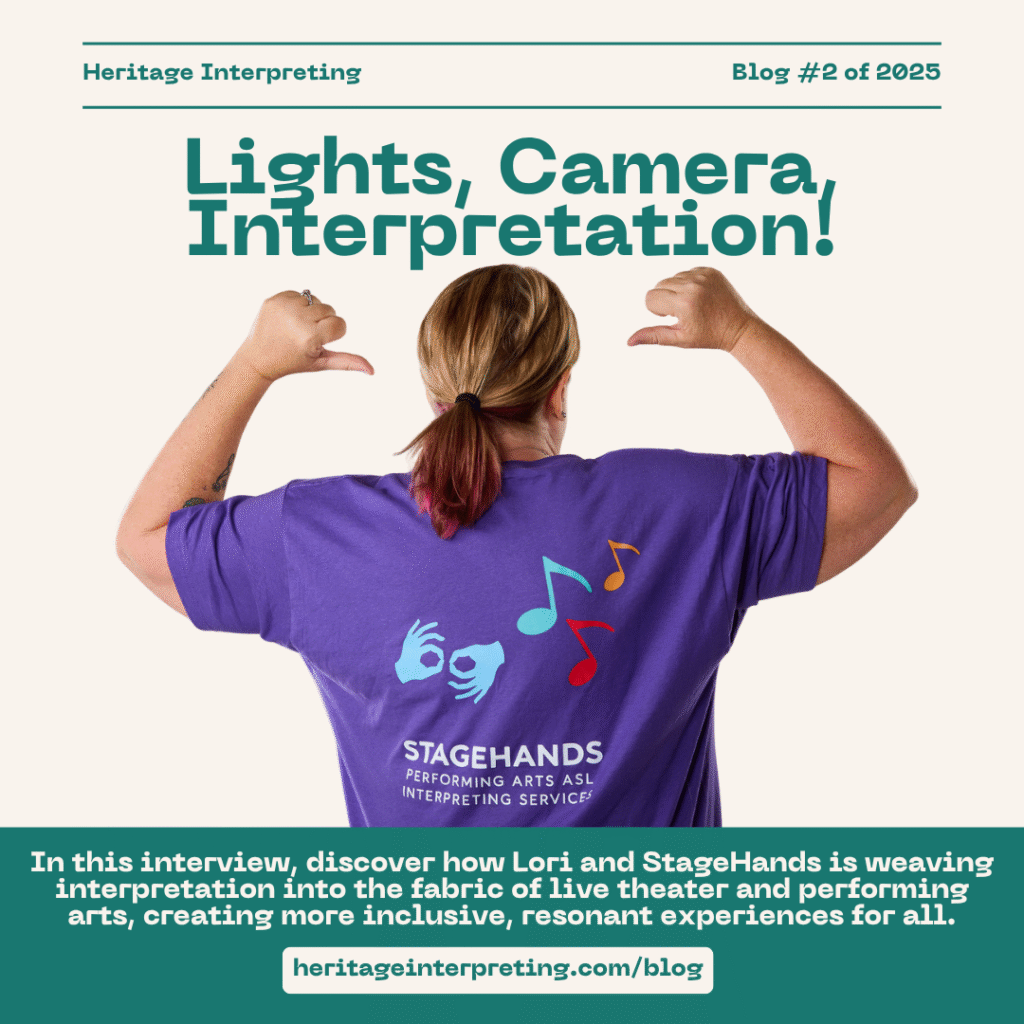
At Heritage Interpreting, we love highlighting the leaders in the sign language interpreting community. Recently, I had the pleasure of signing with Lori Peters — owner and team interpreter at StageHands, a local agency that specializes in interpreting for the performing arts and theater. Keep reading to learn more about Lori’s work and what it takes to bring accessible communication to the stage.
Can you tell us how your company got started and what inspired you to focus on interpreting for the performing arts?
StageHands all started with Meg Tucker, a veteran interpreter and community advocate. She loved both theater and ASL and wanted to bring them together. She studied at The Juilliard School, which is renowned for its world-class performing arts education. While there, she learned key lessons about how ASL can be effectively integrated into theater and live performance.
Meg ran StageHands for more than 35 years. I worked as an interpreter part of her team, and we collaborated on a wide range of projects. When she decided it was time to retire, we discussed the future of StageHands—and eventually, I inherited the business. I became fully invested, and it has grown significantly in recent years. I’m really grateful for the opportunity that Meg entrusted me with.
Meg and I still stay in touch, especially when I’m seeking mentorship or insight about the business. I’ve been running StageHands since 2022, and I’ve loved every single second of it.
When did you realize there was a need for specialized services in theater and performing arts?
About 25 years ago, I was part of a group that signed Christmas songs and events – named “Signs” of Christmas. We performed for local communities, including the Deaf community in the Columbus area. Through those experiences, I saw firsthand how much Deaf individuals enjoy the performing arts—just as much as hearing audiences do. That’s when I realized I wanted to be part of making the arts more accessible for everyone, not just the Deaf community.
I first discovered StageHands when I attended a concert at the Ohio State Fair. StageHands was providing interpreting for the event, and I was awestruck. I reached out to Meg right away, and the rest is history!
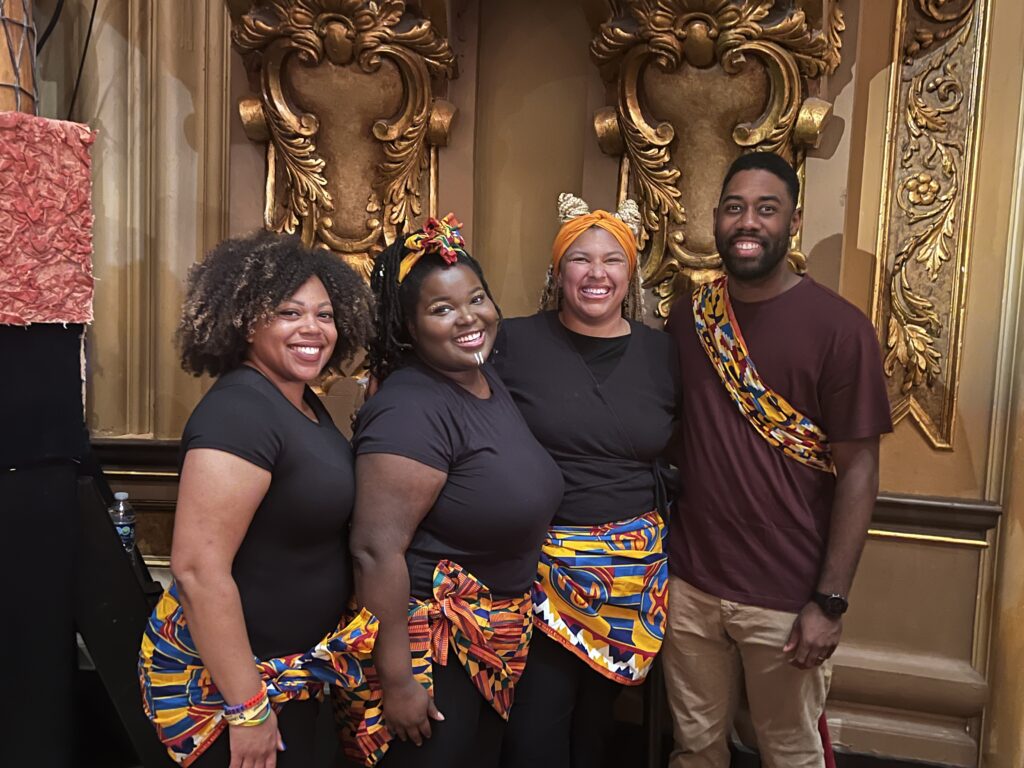
What are the main differences between interpreting everyday conversations and interpreting a live performance?
Practice, practice, practice. With general interpreting—like for a medical appointment—you can prepare by reviewing the information beforehand, doing some research, and going in with confidence. But with theater interpreting, preparation requires a much deeper level of time and commitment. You need to listen to music, identify lyrics, read scripts, write out GLOSS if that helps you, and immerse yourself in the show to feel ready for the event.
In a typical interpreting session, you can adjust your signing if you notice the Deaf client is struggling—there’s feedback you can respond to in real time. On stage, though, there’s no feedback loop. You can’t pause or check in—you just have to trust your preparation and keep going, knowing and trusting that the Deaf audience is following along.
You also need to fully embody characters—mimicking their facial expressions and adjusting your signing to match their tone. Theater interpreting isn’t just about words; it’s about mirroring the emotional and visual elements of the performance.
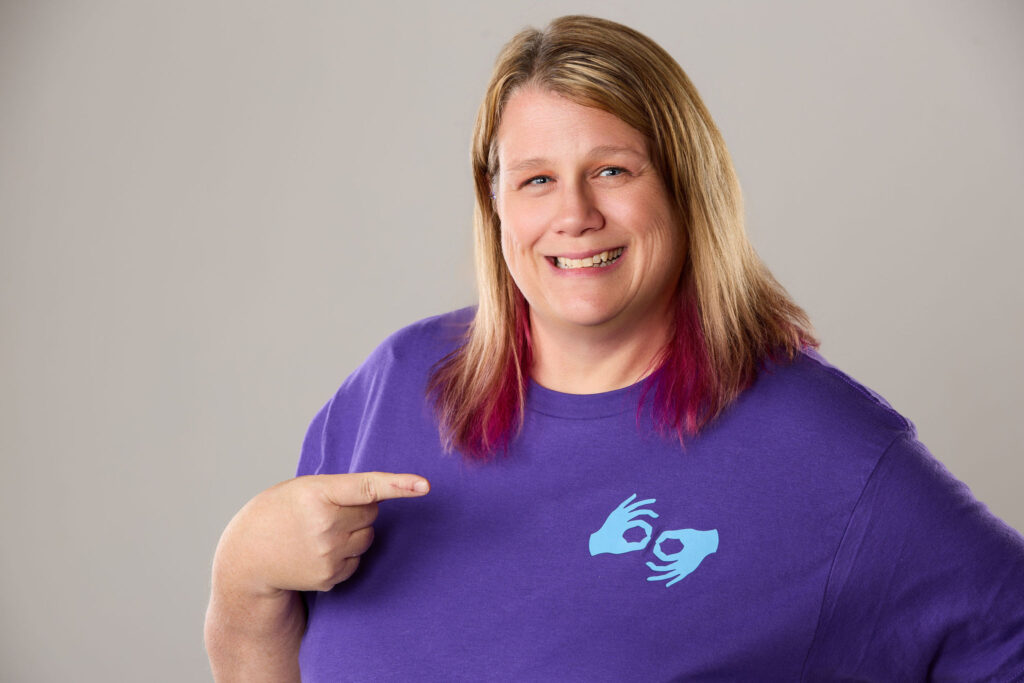
How do you approach translating artistic elements—like song lyrics, idioms, or humor—that may not have direct ASL equivalents?
The most important thing is understanding the director’s vision. What do they want the audience to feel or take away from the show? Once I know that, I make sure my signing aligns with that mood and purpose.
For example, if there’s a pun based on sound, I’ll brainstorm ways before the performance to signal to the Deaf audience that a pun is happening and describe why it’s funny—so they get the joke even if the original wordplay doesn’t translate directly. If the show has a strong romantic theme, I’ll practice how to show that through facial expressions and signing—especially during more intimate or emotional scenes.
Sometimes, instead of signing something literally, I’ll act it out visually. If a character says, “Good day, sir,” it might be more effective to tip an imaginary hat and bow rather than signing the phrase word-for-word. It’s about capturing the spirit of the scene, not just the words.
These kinds of choices made by careful and dedicated preparation beforehand really enhance the experience for Deaf attendees.
Do you attend rehearsals before a show opens? If so, what are you looking for during those rehearsals?
Yes, absolutely. If the show is local, I do my best to attend rehearsals in person. Scripts alone don’t always convey everything I need—I benefit from seeing things live to understand the flow, mood, and movement on stage. Some interpreters are fantastic with just a script, but I prefer having the full visual context.
If I can’t attend in person, I try to get a video recording or find footage online. I’m lucky to be part of a strong theater interpreting network where we share resources and recordings to help each other prepare, so I have alternatives if attending in person for a rehearsal isn’t viable.
During rehearsals, I focus on how certain lines are delivered, identifying key emotional moments, and watching for nonverbal cues like sarcasm or tension that might not come through in the script. I study the characters’ personalities, note which lines carry emotional weight, and identify phrases that could be interpreted in different ways.
Rehearsals help us make sure we’re mirroring those elements accurately—so the Deaf audience experiences the same emotional impact as everyone else.

What techniques do interpreters use to stay visually engaging for Deaf attendees while remaining true to the original script?
There’s a fine line we walk. Deaf attendees are there to see the show, not the interpreters—so we need to stay true to the performance without becoming a distraction.
That said, we do need to visually reflect the characters and tone. Mimicking facial expressions, gestures, and posture helps convey who’s speaking and what’s being said—without becoming overly theatrical ourselves.
Team interpreting is key. Interpreters work together—sometimes using light touch cues, collaborating on role shifts, and keeping body orientation clear for the audience. We avoid overusing role shifts, which can make it harder for the Deaf audience to follow the flow of the performance and to understand the dialogue that is being interpreted.
How do you handle fast-paced dialogue, overlapping lines, or ensemble scenes?
More practice!
In ensemble scenes, I sometimes signal to the audience to focus on the actors—for example, by turning slightly toward the stage. This gives them a cue that it’s okay to take a break from watching us and just absorb the moment visually.
When dialogue overlaps or moves quickly, we rely on rehearsal and preparation to summarize longer lines effectively. With enough practice, you learn how to condense dialogue into a few clear signs that still convey the essence. For overlapping dialogue, we may sign at the same time as a team to reflect the chaos or rhythm of the scene – after all, it’s already hard enough to listen to overlapping spoken dialogue (sometimes impossible) so ensuring that the attendees feel overwhelmed with overlapping conversations is being true to the script.
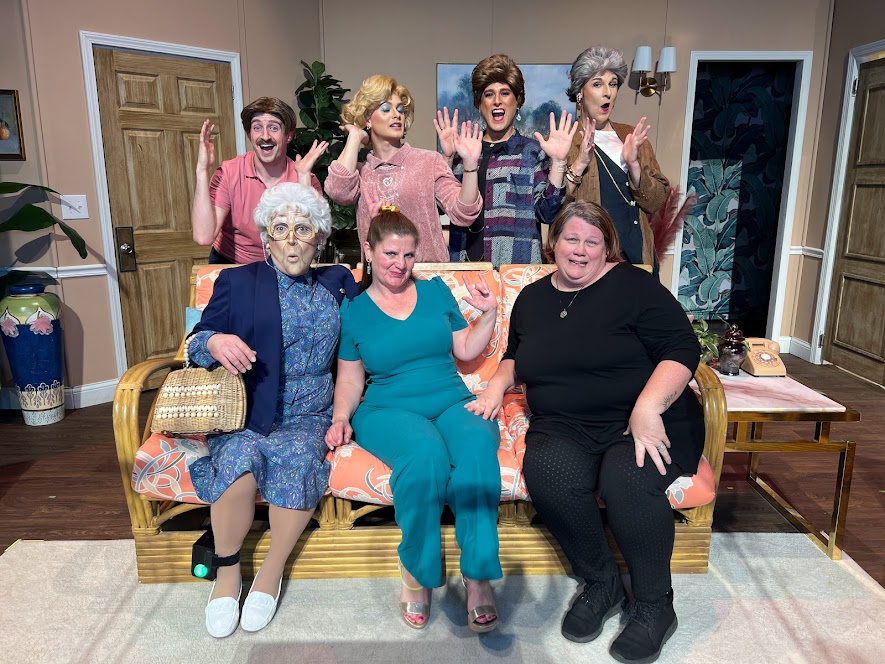
Do you think theater companies are generally doing enough to be accessible to Deaf and hard-of-hearing audiences? How can theaters go beyond just “checking the box” when it comes to accessibility?
We’re making progress. More venues are open to hiring interpreters, and that’s a great step.
The Columbus Association for the Performing Arts (CAPA), for example, has created a disability advisory board to improve accessibility for Deaf patrons. In these board meetings, they address issues that face people with disabilities and listen to their feedback. After collecting all input from the communities, they then implement short-term and long-term solutions to ensure a better experience for all. That’s a fantastic way to do it.
If a theater really wants to go beyond just meeting minimum requirements, they can take a page from CAPA’s book—solicit feedback, act on it, and bring in Deaf (and other disabled) representation to shape those changes.
One current challenge is ticketing. CAPA prefers Deaf patrons to email them to reserve tickets for seating that would give them the best seats that would give them full accessibility to view the show, which can be time-consuming. We’re currently working on and brainstorming solutions for this challenge. I understand they’re trying to prevent scalpers, but it’s an area that could still be improved. But, it’s neat that CAPA is working to ensure that Deaf attendees (and any other people with disabilities) get a chance to reserve the right seats for them.
In the end, it’s about ongoing communication, inclusive planning, and making sure access is built into every part of the experience—not just added at the end.
Do you think theater interpreting is underrepresented or under-taught in Interpreting Training Programs (ITPs)?
Columbus State Community College (CSCC) is doing a great job offering specialty classes. They’ve partnered with Shadowbox Live [a local theater company in Columbus] to offer theater interpreting class once a year, where students can dive into techniques like role shifting, visual storytelling, and character embodiment.
Students interpret for three performances—one a live audience for their instructors but no Deaf attendees. Instructors will provide feedback to students to improve their interpretation before they open up to two shows for live audiences for the public, including Deaf attendees. It’s a great way to build confidence, boost self-esteem, receive feedback, and develop real-world experience in a supportive environment.
That said, I understand that most ITPs focus on day-to-day interpreting needs, like medical or educational settings. But I’ve seen a rise in workshops for performing arts interpreting, and that’s exciting. It allows interpreters to stretch their skills and explore new ways to be expressive and creative.
Sometimes we collaborate with the Deaf community when preparing for a show—seeking feedback, insights, and paying them for their time. Theater interpreting is really a community-driven process.
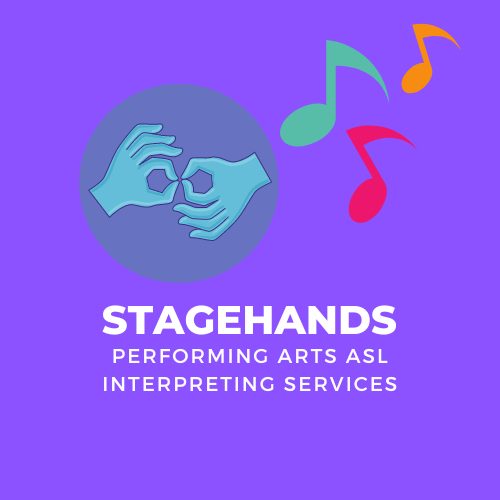
Is there a particular show or performance that has had a lasting impact on you?
Come from Away—it’s a beautiful story about people coming together during a tragedy. I don’t want to go too deep in it but it was so moving, and it left a big impact on me. There’s a performance coming up this February at the Short NorthStage, and I will have a team interpreting the show!
I also want to thank Heritage for this collaboration. It’s such a pleasure to support the public in this way. We have a roster full of incredibly talented interpreters with a wide range of skills, and I’m always confident in matching the right person to each show when Heritage Interpreting and anyone else sends us a request.
Also, I have to give a huge shoutout and a bright spotlight for my team of around 40 interpreters who have been involved in this organization. They’ve spent hours and hours practicing and learning all about interpreting in performing arts and theater. And, of course, a big thank you to the Deaf community for all of your support!

Lori Peters is the owner of StageHands. To learn more about their incredible work or explore exciting opportunities to join, reach out to Lori at [email protected]. You can also follow StageHands on Facebook and Instagram.
StageHands’ Facebook page: facebook.com/ASLStageHands/
StageHands’ Instagram page: instagram.com/asl_stagehands_columbus/

